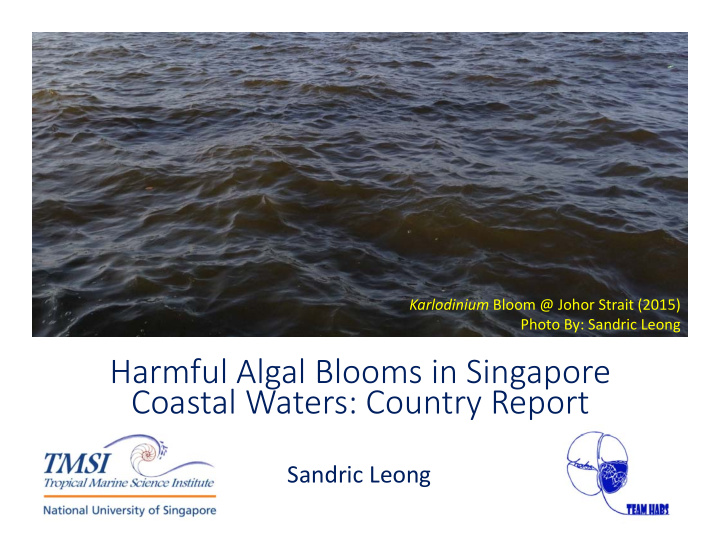



Karlodinium Bloom @ Johor Strait (2015) Photo By: Sandric Leong Harmful Algal Blooms in Singapore Coastal Waters: Country Report Sandric Leong
Training Course Regional Training Course on Identification of Harmful Algal Bloom Species in the ASEAN Region St. John’s Island National Marine Lab, Singapore 18th‐22nd July 2016 Attended by 20 participants from ten countries (Brunei, Cambodia, Indonesia, Laos, Malaysia, Myanmar, Philippines, Singapore, Thailand and Vietnam). Trainers: Dr Y Fukuyo; Dr PT Lim; Dr M Iwataki; Dr S Leong; Dr K Wakita; Dr HC Lim Organized by TMSI NUS, Southeast Asian Fisheries Development Center (SEAFDEC) and Agri-Food & Veterinary Authority of Singapore (AVA). Sponsored by Japan Trust Fund, and in kind contributions by IOC-WESTPAC-HAB), Japan Funds-in-Trust (JFiT), WESTPAC and Asian Natural Environmental Science Center (ANESC).
Singapore Country Report for Year 2014 ‐ 2016 Harmful Algal Blooms in Singapore Coastal Waters Malaysia The first massive bloom occurred along EJS. From 2014, blooms occurred along both EJS and WJS.
Malaysia During early 2015, blooms were initially observed near Seletar Island with high concentration of Karlodinium cells
Singapore Country Report for Year 2014 ‐ 2016 2015 blooms timeline Karenia+ Karlodinium+ Diatoms Karlodinium Bloom Bloom Dec Jan Feb Mar Apr May 2014 2015 24 Mar: mixed species 24 Mar: mixed species bloom at Seletar: bloom at Seletar: 6‐7 Feb: Karlodinium 6‐7 Feb: Karlodinium diatom (≈200 diatom (≈200 count was relatively count was relatively cells/ml)+ Karlodinium + cells/ml)+ Karlodinium + high at near Seletar high at near Seletar Karenia ( ≈400 cells/ml) Karenia ( ≈400 cells/ml) Island: ≈400 cells/ml Island: ≈400 cells/ml
Singapore Country Report for Year 2014 ‐ 2016 Year 2015 Blooms Karlodinium Bloom (6 Feb – 8 Mar) • Main Bloom Species: Karlodinium australe (initially some K . veneficum cells) • Feb 6: Karlodinium cells were detected along east & west Johor Strait, Singapore (200‐400 cells/ml) • Feb 27: Farm fishes were being wiped out at EJS (≈ 600 tons) • Mar 2: Lots of dead wild fishes being observed at WJS • Mar 12: no Karlodinium cells Karenia Bloom (24 Mar– 30 Apr) • Main Bloom Species : Karenia mikimotoi (mixed species bloom) • Mar 24: Detected K. mikimotoi (300 cells/ml) , Karlodinium (400 cells/ml) & diatoms (200 cells/ml) • No fish kills
Singapore Country Report for Year 2014 ‐ 2016 Karlodinium Bloom (6 Feb – 8 Mar) Dead wild fishes Karlodinium bloom
Singapore Country Report for Year 2014 ‐ 2016 50000 50000 Karlodinium spp. (cells ml -1 ) K. mikimotoi (cells ml -1 ) 40000 40000 30000 30000 20000 20000 10000 10000 0 0 1-Feb-15 12-Feb-15 23-Feb-15 6-Mar-15 17-Mar-15 28-Mar-15 8-Apr-15 19-Apr-15 30-Apr-15 Cells density near Seletar Island (unpublished data: Leong et al. (2016)
Malaysia Karenia mikimotoi Bloom (2016) No fish kills
Singapore Country Report for Year 2014 ‐ 2016 Karenia mikimotoi Bloom (2016) Karenia mikimotoi bloom at Johor Strait, Singapore (Jan-Mar 2016) • Jan 5: K. mikimotoi cells started to appear near Seletar Island • Cell density 20,000 cells/ml • Bloomed with other species (similar to bloom observed at Southwest coast of India) • Species: K. mikimotoi, Takayama, Ansanella & diatoms) • First time to observed Ansanella in Singapore water
Singapore Country Report for Year 2014 ‐ 2016 Karenia mikimotoi Bloom (24 Mar – 30 Apr)
Singapore Country Report for Year 2014 ‐ 2016 Characteristics of Karenia mikimotoi bloom 30 Jan 2016 100 0 Map of bloom patches using optical sensors mounted on autonomous vehicles • Blooms normally occurred in patches. They were not evenly distributed horizontally and vertically.
Bloom of Karenia mikimotoi Si & P: limitation ‐ low 1st appearance 5 Jan (unpublished data: Leong et al. (2016)
Capacity Development ‐ Training of Research Team • Sept 2016: Molecular training workshop at Bachok Marine Station, Malaysia – Rapid detection of bloom species using molecular technique • Nov 2016: Molecular workshop at TMSI (Aquatic Genomics Research Centre, National Research Institute of Fisheries Science (Japan); Bachok Marine Station Group) – Gathering information and building a database for bloom-forming species using metagenomic approach • Dec 2016: Seminar with Singapore agencies (National Institute of Fisheries Science, S. Korea) – Clay Application and Aquaculture management
Problems • Specific harm of the bloom (toxic or non-toxic? harmful or not?) • The threshold to alert for instance during a Karlodinium blooms • Spatio-temporal variability • Spatial extent and intensity of blooms • Rapid detection of species (new species?)
Scientific Topics 1. Killing mechanism of species such as K. mikimotoi and K. australe 2. Rapid detection of bloom species 3. Environmental factors that will promote fish kills 4. Warning system such as threshold. What kind of threshold?
teamhabs.info
Recommend
More recommend